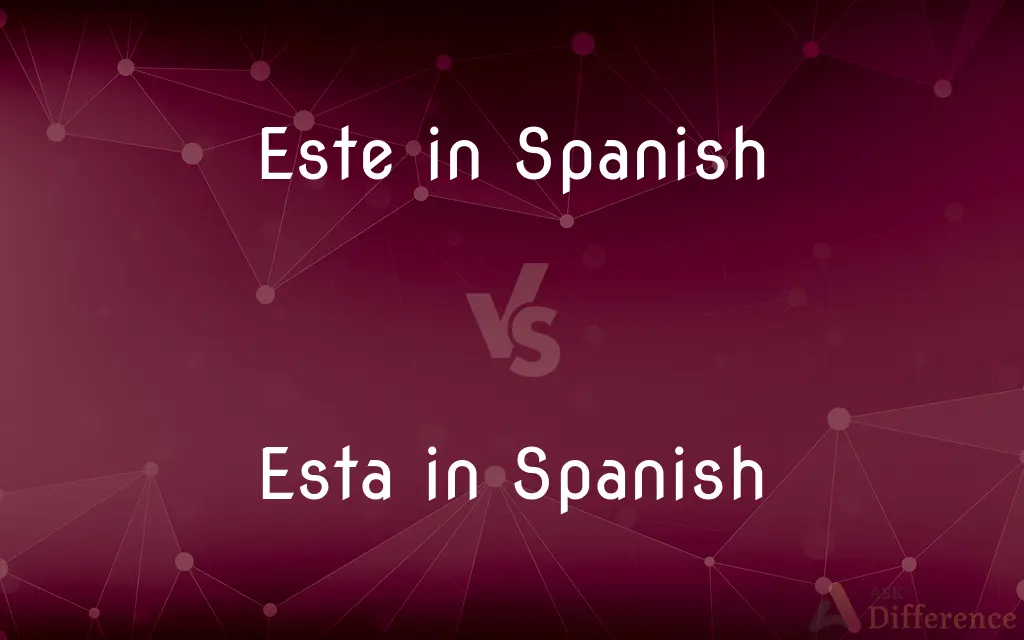Este in Spanish vs. Esta in Spanish — What's the Difference?
By Tayyaba Rehman — Published on January 16, 2024
In Spanish, "este" is a masculine demonstrative adjective meaning "this", while "esta" is its feminine form, also meaning "this".

Difference Between Este in Spanish and Esta in Spanish
Table of Contents
ADVERTISEMENT
Key Differences
Gender Agreement: "Este" is used with masculine nouns (e.g., este libro - this book), whereas "esta" is used with feminine nouns (e.g., esta casa - this house).
Demonstrative Usage: Both "este" and "esta" are demonstrative adjectives used to indicate something close to the speaker. The choice depends on the gender of the noun they modify.
Examples in Sentences: In the sentence "Este perro es grande" (This dog is big), "este" is used because "perro" (dog) is masculine. In "Esta mesa es redonda" (This table is round), "esta" is used for the feminine noun "mesa" (table).
Pronoun Usage: Both can also act as demonstrative pronouns, replacing the noun. For example, "Este es mío" (This one is mine) and "Esta es bonita" (This one is pretty).
Consistency in Communication: Using the correct form ensures clarity and grammatical accuracy in Spanish, reflecting the gendered nature of Spanish nouns.
ADVERTISEMENT
Comparison Chart
Gender Association
Masculine
Feminine
Example with Noun
Este libro (This book)
Esta casa (This house)
Use as Pronoun
Este es azul (This one is blue)
Esta es roja (This one is red)
Agreement with Nouns
Agrees with masculine nouns
Agrees with feminine nouns
Contextual Example
Este coche es rápido (This car is fast)
Esta flor es hermosa (This flower is beautiful)
Compare with Definitions
Este in Spanish
Emphasizing Specificity: To specify a particular masculine noun.
Este problema necesita atención (This problem needs attention).
Esta in Spanish
Emphasizing Specificity: To specify a particular feminine noun.
Esta idea es revolucionaria (This idea is revolutionary).
Este in Spanish
In Comparisons: To compare something nearby.
Este es mejor que aquel (This is better than that).
Esta in Spanish
In Comparisons: To compare something nearby.
Esta es más cara que aquella (This is more expensive than that).
Este in Spanish
Indicating Proximity: Used for something near in space or time.
Este día es importante (This day is important).
Esta in Spanish
Indicating Proximity: Used for something near in space or time.
Esta mañana está soleada (This morning is sunny).
Este in Spanish
As a Pronoun: Replaces a masculine noun.
¿Ves este? (Do you see this one?)
Esta in Spanish
Demonstrative Adjective: Refers to a feminine noun close to the speaker.
Esta mesa es nueva (This table is new).
Este in Spanish
Demonstrative Adjective: Refers to a masculine noun close to the speaker.
Este libro es interesante (This book is interesting).
Esta in Spanish
As a Pronoun: Replaces a feminine noun.
Esta es la mía (This one is mine).
Common Curiosities
What does este mean in Spanish?
Este means this for masculine nouns.
Is esta used for objects far away?
No, it's used for objects that are near.
Can este function as a pronoun?
Yes, it can replace a masculine noun.
Are there similar words in other Romance languages?
Yes, demonstrative adjectives are common in Romance languages.
What does esta mean in Spanish?
Esta means this for feminine nouns.
Can este be used with any noun?
Only with masculine nouns.
Is the pronunciation of este and esta different?
Yes, slightly, due to the ending vowel.
Can este and esta be used for abstract concepts?
Yes, if the concepts have a gender in Spanish.
Can esta function as a pronoun?
Yes, it can replace a feminine noun.
Are este and esta used in formal contexts?
Yes, in both formal and informal contexts.
Do este and esta have synonyms in Spanish?
Not exact synonyms, but similar words include esto and esa.
How do I know when to use este or esta?
It depends on the gender of the noun it refers to.
Is it common to confuse este and esta?
For Spanish learners, it can be a common mistake.
Do este and esta change in plural form?
Yes, to estos (masculine) and estas (feminine).
How important is gender agreement with este and esta?
Very important for grammatical accuracy in Spanish.
Share Your Discovery

Previous Comparison
CeraVe vs. Lubriderm
Next Comparison
Cuprous Oxide vs. Cupric OxideAuthor Spotlight
Written by
Tayyaba RehmanTayyaba Rehman is a distinguished writer, currently serving as a primary contributor to askdifference.com. As a researcher in semantics and etymology, Tayyaba's passion for the complexity of languages and their distinctions has found a perfect home on the platform. Tayyaba delves into the intricacies of language, distinguishing between commonly confused words and phrases, thereby providing clarity for readers worldwide.
















































